Oral Presentation
Download as PPTX, PDF1 like723 views
The document summarizes a student project to design, develop, and test a delta wing unmanned aerial vehicle (UAV). The goals of the project were to design and manufacture a delta wing UAV for surveillance and data acquisition. Various software tools were used for the design including XFLR5 for airfoil analysis, ANSYS Fluent for computational fluid dynamics simulations of wing flow, and ANSYS Workbench for structural analysis. Results of the analyses are presented along with limitations and recommendations for future work, such as adding a surveillance camera, flight data recorder, and autonomous flight capabilities.
1 of 15
Downloaded 23 times
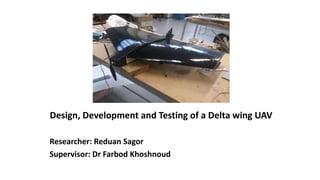
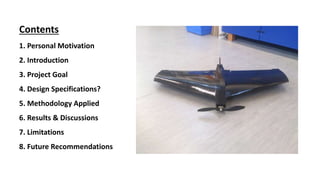
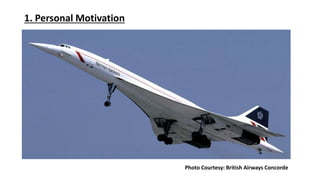
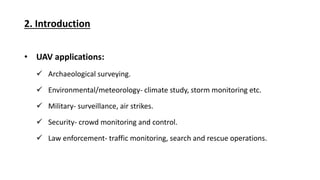
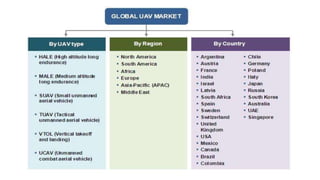
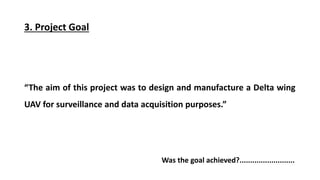
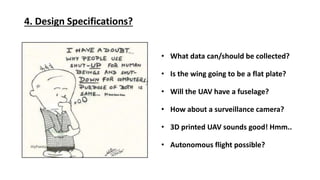
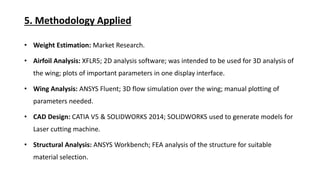
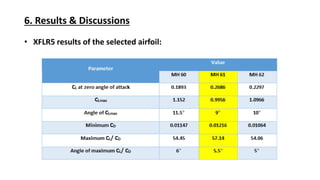
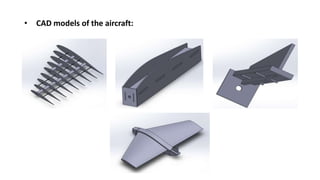
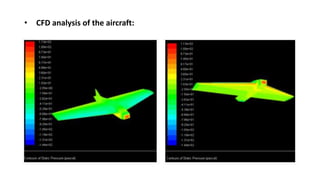

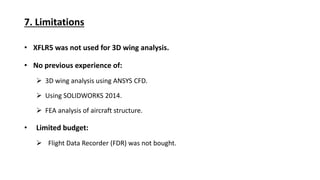
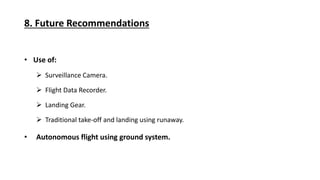

Recommended
Computational Study On Eppler 61 Airfoil



Computational Study On Eppler 61 Airfoilkushalshah911
Ėý
The document analyzes the Eppler 61 airfoil using computational fluid dynamics (CFD) software XFLR5 and Fluent to simulate low Reynolds number flows. The results are compared to experimental data to validate that the Eppler 61 airfoil performs well at low Reynolds numbers, making it suitable for micro air vehicles. CFD simulations are conducted at Reynolds numbers of 46,000, 87,000 and 160,000 and angles of attack from -4 to 16 degrees with and without tripping to study separation bubbles. The computational results reasonably match the experimental data.Presentation on delta wing



Presentation on delta wingMahesh Patil
Ėý
This document discusses Mahesh Patil's thermal science research project which involves analyzing the flow over a delta wing using computational fluid dynamics (CFD). The project has two phases: a literature review phase involving five research papers on vortex breakdown and control over delta wings, and a CFD analysis phase. The research papers investigate vortex breakdown using experiments, Reynolds-averaged Navier-Stokes equations with different turbulence models, and particle image velocimetry (PIV) to analyze flow structures. The CFD analysis will evaluate the thermal performance of an automobile radiator with a delta wing configuration.DeltaWingPoster



DeltaWingPosterNathaniel Locke
Ėý
Three delta wings with sweep angles of 43, 53, and 63 degrees were tested in a wind tunnel at angles of attack of 15, 30, and 45 degrees. Oil flow visualization showed that the 53 degree wing at 30 degrees of attack produced the most concentrated vortices, seen as distinct lines of oil. At higher angles of attack, the flow became more disrupted. The 43 degree wing showed a trailing edge vortex at 45 degrees, indicating a possible stall. The 63 degree wing produced small and large vortices at the edges at 15 degrees of attack, seen as a defined separation line.Heat transfer enhancement using delta wing



Heat transfer enhancement using delta wingMahesh Patil
Ėý
The document discusses boundary layer theory and its application to heat transfer enhancement using a delta wing on a flat plate. It covers thermal and velocity boundary layers, the geometry and meshing used to model temperature variation on a flat plate, and how modeling a delta wing can increase heat transfer. The conclusion indicates heat transfer increases with a delta wing and future work could examine wing location and orientation.DDI Aircraft OML Scanning and Modeling Presentation Oct 2009



DDI Aircraft OML Scanning and Modeling Presentation Oct 2009Direct Dimensions, Inc.
Ėý
There are many reasons why firmsĖýneed to modelĖýthe exterior contour of existing aircraft OMLs (Outer Mold Lines).Ėý ĖýMost aircraft flying today were not designed in a modern 3D CAD program.Ėý Even with a current 3D digital design, the actual as-built contour deviates from the intended shape, at least at some level.
Ėý
Direct Dimensions has used a wide variety of 3D measurement equipment and software for nearly 15 years to accurately capture and modelĖýthese shapes for many different applications and purposes.Ėý This presentation will focus on the evolution of 3D scanning equipment and software through many examples with emphasis on practical application, costs, schedules, deliverables, etc.Ėý
Ėý
Having real world customers that demand higher quality and lower price over time for this application, Direct Dimensions has continually searched for the best tools and methods for performing these projects.Ėý This experience and perspective will be freelyĖýshared with the audience in order toĖýdevelop an appreciation for the selection of such tools for these projects.DDI Aircraft OML Scanning and Modeling Presentation Oct 2009



DDI Aircraft OML Scanning and Modeling Presentation Oct 2009Direct Dimensions, Inc.
Ėý
There are many reasons why firmsĖýneed to modelĖýthe exterior contour of existing aircraft OMLs (Outer Mold Lines).Ėý ĖýMost aircraft flying today were not designed in a modern 3D CAD program.Ėý Even with a current 3D digital design, the actual as-built contour deviates from the intended shape, at least at some level.
Ėý
Direct Dimensions has used a wide variety of 3D measurement equipment and software for nearly 15 years to accurately capture and modelĖýthese shapes for many different applications and purposes.Ėý This presentation will focus on the evolution of 3D scanning equipment and software through many examples with emphasis on practical application, costs, schedules, deliverables, etc.Ėý
Ėý
Having real world customers that demand higher quality and lower price over time for this application, Direct Dimensions has continually searched for the best tools and methods for performing these projects.Ėý This experience and perspective will be freelyĖýshared with the audience in order toĖýdevelop an appreciation for the selection of such tools for these projects.4.1. CLASS.pptx



4.1. CLASS.pptxNilamadhabMishra7
Ėý
The document discusses building drone prototypes, gilding drones, and racing drones. It provides steps for designing and testing a drone prototype, including defining the use case, researching existing solutions, designing the prototype, testing it, iterating based on test results, and documenting the process. Gilding drones, also called glider drones, can fly without propulsion by exploiting rising air currents. They are capable of extended flight durations and some have small batteries. Racing drones are customized for speed and maneuverability, with powerful motors and advanced flight control for executing precise maneuvers through obstacle courses."Click here" to build your UAV



"Click here" to build your UAVDirk Gorissen
Ėý
This document provides an overview of a talk given by Dirk Gorissen on UAV and robotics technology. The talk discusses the DECODE project, which aims to develop a system to help designers understand the impact of decisions made during complex aerospace system design. As a case study, the project is using UAV design for search and rescue operations. The talk outlines UAV and robot technologies, the DECODE design system, rapid manufacturing techniques like 3D printing, and future work such as a two-seas monitoring project using UAVs.Aircraft Design Synthesis and Analysis.pdf



Aircraft Design Synthesis and Analysis.pdfCarrie Tran
Ėý
This document provides an overview and instructions for using an online textbook on aircraft design called "Aircraft Design: Synthesis and Analysis". It is being developed and released in versions by Desktop Aeronautics, Inc. The textbook covers various topics related to aircraft design through chapters, examples, and interactive programs. It is intended to be used online through a web browser and utilizes frames and other features that require newer browser versions. The document provides navigation instructions and notes areas still under development.Point Clouds from Rolling Shutter Cameras



Point Clouds from Rolling Shutter CamerasChristoph Strecha
Ėý
This document discusses point clouds generated from images taken with rolling shutter cameras on consumer drones. It contains the following key points:
1) Pix4D software can model geometric distortions from rolling shutter cameras to improve mapping accuracy, allowing drones to be flown at higher speeds.
2) Experiments show rolling shutter modeling improves results for all rolling shutter cameras, bringing accuracies to the usual 2-3 pixel range. It does not negatively impact accuracy for global shutter cameras.
3) Accuracy from rolling shutter modeling increases with drone flight speed, and global shutter cameras tend to be slightly more accurate than rolling shutter cameras.End of Semester Design Report Final Version



End of Semester Design Report Final VersionDaniel Worts
Ėý
This document presents a proposal for an autonomous quadcopter senior design project. The goal is to design and build a quadcopter capable of GPS waypoint navigation with multiple flight modes and safety features. Key specifications include a 15 minute maximum flight time, 0.75 mile video transmission range, object avoidance sensors, and a parachute system for failures. The design process will focus on a durable yet lightweight frame and reducing vibrations to ensure smooth video and avoid interfering with electronics. By spring, the team aims to have a functional quadcopter with altitude control via manual controller and autonomous software, while transmitting video.WSE 6A-Octo-X Terrain Mapping UAV



WSE 6A-Octo-X Terrain Mapping UAVManuel De La Cruz
Ėý
The document summarizes a student project to develop an unmanned aerial vehicle (UAV) for terrain mapping. The goals were to build a functional UAV that could collect lidar data and video to create digital elevation models. Software included MATLAB and C++ for autonomous flight control. Hardware included a Pixhawk flight controller, GPS, lidar sensor, and other components. Initial simulated flight tests were promising. Future work would include live testing and controller optimization. Students learned lessons about scheduling, equipment choices, and communication.Dhruv Drone Thesis FInal PPT



Dhruv Drone Thesis FInal PPTDhruv Tandon
Ėý
The document discusses a student's final presentation on innovative applications of drone technology. It begins with an overview of the student's pre-mid semester work, which included understanding drone terminology, applications, flight physics, and creating a drone database. It then discusses using the MADM (TOPSIS) technique to analyze the database based on expert opinion surveys. Key features were identified for different application areas like photography, agriculture, mapping. An innovative application of medicinal supply in disasters is analyzed. The document concludes with discussing potential future work like identifying new applications and features.Main Project - FINAL COPY 786



Main Project - FINAL COPY 786Rohit Sai Raj
Ėý
This document is a project report on the design and fabrication of a quadcopter. It was submitted by two students in partial fulfillment of their Bachelor of Technology degree in Mechanical Engineering. The report covers modeling the quadcopter in Pro-E software, selecting hardware components, developing control software, assembly, and flight testing. While hardware issues prevented full testing, the students were able to complete a hands-free hover demonstration and other tests showing the quadcopter's stability and potential 6-8 minute flight time.Ppt. Micro air vehicel



Ppt. Micro air vehicelMukesh kumar
Ėý
Mukesh Kumar's presentation discusses micro air vehicles (MAVs), which are unmanned aerial vehicles smaller than 15 cm. MAVs were originally developed for military intelligence, surveillance, and reconnaissance applications to allow remote observation of hazardous environments. The history of MAV development from the 1990s by organizations like MIT Lincoln Labs and DARPA is reviewed. Potential new indoor uses for MAVs are presented, along with considerations for future MAV design, such as prioritizing useful use cases over technology-driven requirements. Advantages of MAVs include being small and able to access places previously inaccessible, while disadvantages include being an immature technology and potential misuse if the technology falls into the wrong hands.poster1



poster1Hassen Hassaieir
Ėý
This document summarizes a study and design of an unmanned aerial vehicle (UAV) according to a specified datasheet. The study identified the type of aircraft needed by the client, discussed the main components, and used CFD tools to simulate airfoils and wings. A design was then created based on the CFD results. Finally, a prototype was built to apply similitude rules and test the model's performance in order to build the real aircraft.internship presentation (4).pptx



internship presentation (4).pptxaishsoftwares
Ėý
This document summarizes a student project involving building and programming a quadcopter drone. The student learned skills in basic electronics, machine assembly, C++ programming and soldering. Components of the quadcopter included motors, propellers, a flight controller, battery and a radio receiver. The student assembled the drone, tested its ability to fly in a stable manner, and gained experience in robot design and microcontroller programming, though the goal of autonomous obstacle sensing was not fully achieved within the given time frame.Neboneed Farhadi's Experience Portfolio 



Neboneed Farhadi's Experience Portfolio Neboneed Farhadi
Ėý
This document provides an overview of Neboneed Farhadi's experience portfolio, including:
- A Bachelor's degree in Aerospace Engineering and over 1.5 years of industry experience.
- Coursework and projects in areas like aircraft design, CAD, CFD, and robotics.
- Recent engineering work experience at Bloom Energy in remote monitoring and technical support.
- Additional non-engineering internship experience in hydrology data analysis.Application of Drones for Mining Ooperations



Application of Drones for Mining OoperationsDr. Alex Vyazmensky
Ėý
Drones are increasingly being used in mining operations to help improve safety, efficiency and planning. They can conduct surveys of pits, stockpiles, tailings dams and other areas to produce 3D spatial data and maps. This data helps with tasks like short-term mine planning, production blast reconciliation, and monitoring geological or stability conditions. Drones allow remote access to hazardous or hard to reach areas, helping streamline workflows. While drone technology is advancing rapidly, their use in mining still faces some limitations from regulations, operating constraints, and the need for careful risk analysis when flying near equipment and personnel. As drones get smaller, cheaper and more integrated with autonomous systems, their applications in mining are expected to continue growing significantly.A Review of Stealth Technology



A Review of Stealth Technologyijtsrd
Ėý
This document provides an overview of stealth technology used in aircraft. It begins with a brief history of stealth technology development starting in World War 2 and its use in modern aircraft like the B-2 bomber and F-117 fighter. It then discusses key techniques used in stealth technology, including shaping aircraft to deflect radar signals, using radar absorbent materials to reduce an aircraft's radar cross section, and managing infrared signatures. The document notes stealth technology allows aircraft to avoid detection but comes with higher development and maintenance costs compared to conventional aircraft. It concludes stealth capabilities provide important advantages in military operations.Hexacopter k ucopter



Hexacopter k ucopterAl Mtdrs
Ėý
This document describes the design and development of a hexa-copter (six rotor drone) called the KU-COPTER for environmental research applications. It discusses how the design of the hexa-copter frame was based on the logo of Kathmandu University, and various materials for the frame like aluminum composite panel and PVC foam were considered through simulations to optimize strength and weight. The developed hexa-copter is intended to enable applications like aerial surveillance, photogrammetry, and delivery for environmental research while being a low-cost alternative to manned aircrafts.DRONE PPT.pptx



DRONE PPT.pptxRishabhKumar917984
Ėý
This document discusses different types of drones and their parts. It describes four main types of drones: multi-rotor drones with multiple rotors like quadcopters; fixed wing drones that function like airplanes; single rotor drones similar to helicopters; and fixed wing hybrid drones that can hover and fly horizontally. It outlines key parts of drones like flight controllers, sensors for navigation and stabilization. It provides steps for flight preparation and calibration. Finally, it lists benefits of using drone systems like risk-free data collection from the sky and fast decision making.Building Airpad for McFly.Aero



Building Airpad for McFly.AeroDimitri Popov
Ėý
The document discusses developing a standard landing pad called an "airpad" for air taxis. It proposes engaging helipad engineering firms to design an airpad that can be used across the industry as a standard and potential business opportunity. Key considerations for the airpad design include functionality, use cases, types and locations of installations, and regulatory requirements. The goal is to create a draft design, get feedback from firms, and finalize the design of an industry standard airpad.2016DBF_GEORGIA_INSTITUTE_OF_TECHNOLOGY_DESIGN_REPORT



2016DBF_GEORGIA_INSTITUTE_OF_TECHNOLOGY_DESIGN_REPORTLansing Wei
Ėý
The document provides details on the design of two aircraft, a Manufacturing Support Aircraft (MSA) and Production Aircraft (PA), for the 2015-2016 AIAA Design/Build/Fly competition. Key aspects of the design include:
- The PA is designed to have a single subassembly to maximize the competition score. It has a conventional high wing configuration.
- The MSA is designed in multiple sections to fit around and transport subassemblies of the PA.
- Both aircraft are designed to have minimal weight through efficient structures and use of composite materials, in order to maximize the competition score.
- Extensive testing was conducted involving 31 test flights to validate the design assumptions.2014 PV Reliability, Operations & Maintenance Workshop: HelioSpec by DreamQii...



2014 PV Reliability, Operations & Maintenance Workshop: HelioSpec by DreamQii...Sandia National Laboratories: Energy & Climate: Renewables
Ėý
HelioSpec uses multiple drones (a "swarm") equipped with cameras and sensors to efficiently inspect large photovoltaic (PV) solar sites. The drones can autonomously follow pre-programmed flight paths, communicate with each other, and capture high-resolution imagery and data. Operators can control multiple drones simultaneously and processed data is transferred to the cloud. HelioSpec also manages drone pilot training, regulatory compliance, and provides inspection services on a pay-per-use basis to reduce capital costs for customers. UAV inspection allows sites to be scanned quickly from optimal angles to diagnose various PV system errors and potential problems.Ultimate History of All Things Drones



Ultimate History of All Things DronesDavid W. Ewing
Ėý
The document provides information on drones (also called unmanned aircraft systems) including their history, uses, classification, safety and legal requirements for operation. It discusses the origins of the term "drone" and lists common names for different types of drones. The document also outlines the key components of drones like quadcopters and explains how drones work from both an external operational perspective and internal electronics perspective.Robotic Arm 5 degree of freedom (5 DOF)



Robotic Arm 5 degree of freedom (5 DOF)Abdul Rehman Memon
Ėý
This document presents a final year project on modelling and fabricating a 5 degree of freedom robotic arm. The objectives were to model the arm using CAD software, select materials and components, perform torque calculations, and analyze the workspace and kinematics. A group of students designed and built a prototype arm controlled by an Arduino mega board without any external controls. Future recommendations include adding measurement devices and controlling the arm with Matlab instead of Arduino. The project aimed to teach robotics concepts and could be useful for educational purposes.Report



ReportShoaib Zafar
Ėý
The document describes a project to design and construct an unmanned aerial vehicle (UAV). A group of 6 students will work together on the project under an instructor. They have selected a fixed wing UAV called the FPV SkyVU-10 as their design. The document outlines their design process, including AutoCAD drawings, calculations, budget, construction steps, task assignments, and a Gantt chart schedule. Their goal is to complete the design, construction, testing, and report on the project by the end of the semester.More Related Content
Similar to Oral Presentation (20)
Aircraft Design Synthesis and Analysis.pdf



Aircraft Design Synthesis and Analysis.pdfCarrie Tran
Ėý
This document provides an overview and instructions for using an online textbook on aircraft design called "Aircraft Design: Synthesis and Analysis". It is being developed and released in versions by Desktop Aeronautics, Inc. The textbook covers various topics related to aircraft design through chapters, examples, and interactive programs. It is intended to be used online through a web browser and utilizes frames and other features that require newer browser versions. The document provides navigation instructions and notes areas still under development.Point Clouds from Rolling Shutter Cameras



Point Clouds from Rolling Shutter CamerasChristoph Strecha
Ėý
This document discusses point clouds generated from images taken with rolling shutter cameras on consumer drones. It contains the following key points:
1) Pix4D software can model geometric distortions from rolling shutter cameras to improve mapping accuracy, allowing drones to be flown at higher speeds.
2) Experiments show rolling shutter modeling improves results for all rolling shutter cameras, bringing accuracies to the usual 2-3 pixel range. It does not negatively impact accuracy for global shutter cameras.
3) Accuracy from rolling shutter modeling increases with drone flight speed, and global shutter cameras tend to be slightly more accurate than rolling shutter cameras.End of Semester Design Report Final Version



End of Semester Design Report Final VersionDaniel Worts
Ėý
This document presents a proposal for an autonomous quadcopter senior design project. The goal is to design and build a quadcopter capable of GPS waypoint navigation with multiple flight modes and safety features. Key specifications include a 15 minute maximum flight time, 0.75 mile video transmission range, object avoidance sensors, and a parachute system for failures. The design process will focus on a durable yet lightweight frame and reducing vibrations to ensure smooth video and avoid interfering with electronics. By spring, the team aims to have a functional quadcopter with altitude control via manual controller and autonomous software, while transmitting video.WSE 6A-Octo-X Terrain Mapping UAV



WSE 6A-Octo-X Terrain Mapping UAVManuel De La Cruz
Ėý
The document summarizes a student project to develop an unmanned aerial vehicle (UAV) for terrain mapping. The goals were to build a functional UAV that could collect lidar data and video to create digital elevation models. Software included MATLAB and C++ for autonomous flight control. Hardware included a Pixhawk flight controller, GPS, lidar sensor, and other components. Initial simulated flight tests were promising. Future work would include live testing and controller optimization. Students learned lessons about scheduling, equipment choices, and communication.Dhruv Drone Thesis FInal PPT



Dhruv Drone Thesis FInal PPTDhruv Tandon
Ėý
The document discusses a student's final presentation on innovative applications of drone technology. It begins with an overview of the student's pre-mid semester work, which included understanding drone terminology, applications, flight physics, and creating a drone database. It then discusses using the MADM (TOPSIS) technique to analyze the database based on expert opinion surveys. Key features were identified for different application areas like photography, agriculture, mapping. An innovative application of medicinal supply in disasters is analyzed. The document concludes with discussing potential future work like identifying new applications and features.Main Project - FINAL COPY 786



Main Project - FINAL COPY 786Rohit Sai Raj
Ėý
This document is a project report on the design and fabrication of a quadcopter. It was submitted by two students in partial fulfillment of their Bachelor of Technology degree in Mechanical Engineering. The report covers modeling the quadcopter in Pro-E software, selecting hardware components, developing control software, assembly, and flight testing. While hardware issues prevented full testing, the students were able to complete a hands-free hover demonstration and other tests showing the quadcopter's stability and potential 6-8 minute flight time.Ppt. Micro air vehicel



Ppt. Micro air vehicelMukesh kumar
Ėý
Mukesh Kumar's presentation discusses micro air vehicles (MAVs), which are unmanned aerial vehicles smaller than 15 cm. MAVs were originally developed for military intelligence, surveillance, and reconnaissance applications to allow remote observation of hazardous environments. The history of MAV development from the 1990s by organizations like MIT Lincoln Labs and DARPA is reviewed. Potential new indoor uses for MAVs are presented, along with considerations for future MAV design, such as prioritizing useful use cases over technology-driven requirements. Advantages of MAVs include being small and able to access places previously inaccessible, while disadvantages include being an immature technology and potential misuse if the technology falls into the wrong hands.poster1



poster1Hassen Hassaieir
Ėý
This document summarizes a study and design of an unmanned aerial vehicle (UAV) according to a specified datasheet. The study identified the type of aircraft needed by the client, discussed the main components, and used CFD tools to simulate airfoils and wings. A design was then created based on the CFD results. Finally, a prototype was built to apply similitude rules and test the model's performance in order to build the real aircraft.internship presentation (4).pptx



internship presentation (4).pptxaishsoftwares
Ėý
This document summarizes a student project involving building and programming a quadcopter drone. The student learned skills in basic electronics, machine assembly, C++ programming and soldering. Components of the quadcopter included motors, propellers, a flight controller, battery and a radio receiver. The student assembled the drone, tested its ability to fly in a stable manner, and gained experience in robot design and microcontroller programming, though the goal of autonomous obstacle sensing was not fully achieved within the given time frame.Neboneed Farhadi's Experience Portfolio 



Neboneed Farhadi's Experience Portfolio Neboneed Farhadi
Ėý
This document provides an overview of Neboneed Farhadi's experience portfolio, including:
- A Bachelor's degree in Aerospace Engineering and over 1.5 years of industry experience.
- Coursework and projects in areas like aircraft design, CAD, CFD, and robotics.
- Recent engineering work experience at Bloom Energy in remote monitoring and technical support.
- Additional non-engineering internship experience in hydrology data analysis.Application of Drones for Mining Ooperations



Application of Drones for Mining OoperationsDr. Alex Vyazmensky
Ėý
Drones are increasingly being used in mining operations to help improve safety, efficiency and planning. They can conduct surveys of pits, stockpiles, tailings dams and other areas to produce 3D spatial data and maps. This data helps with tasks like short-term mine planning, production blast reconciliation, and monitoring geological or stability conditions. Drones allow remote access to hazardous or hard to reach areas, helping streamline workflows. While drone technology is advancing rapidly, their use in mining still faces some limitations from regulations, operating constraints, and the need for careful risk analysis when flying near equipment and personnel. As drones get smaller, cheaper and more integrated with autonomous systems, their applications in mining are expected to continue growing significantly.A Review of Stealth Technology



A Review of Stealth Technologyijtsrd
Ėý
This document provides an overview of stealth technology used in aircraft. It begins with a brief history of stealth technology development starting in World War 2 and its use in modern aircraft like the B-2 bomber and F-117 fighter. It then discusses key techniques used in stealth technology, including shaping aircraft to deflect radar signals, using radar absorbent materials to reduce an aircraft's radar cross section, and managing infrared signatures. The document notes stealth technology allows aircraft to avoid detection but comes with higher development and maintenance costs compared to conventional aircraft. It concludes stealth capabilities provide important advantages in military operations.Hexacopter k ucopter



Hexacopter k ucopterAl Mtdrs
Ėý
This document describes the design and development of a hexa-copter (six rotor drone) called the KU-COPTER for environmental research applications. It discusses how the design of the hexa-copter frame was based on the logo of Kathmandu University, and various materials for the frame like aluminum composite panel and PVC foam were considered through simulations to optimize strength and weight. The developed hexa-copter is intended to enable applications like aerial surveillance, photogrammetry, and delivery for environmental research while being a low-cost alternative to manned aircrafts.DRONE PPT.pptx



DRONE PPT.pptxRishabhKumar917984
Ėý
This document discusses different types of drones and their parts. It describes four main types of drones: multi-rotor drones with multiple rotors like quadcopters; fixed wing drones that function like airplanes; single rotor drones similar to helicopters; and fixed wing hybrid drones that can hover and fly horizontally. It outlines key parts of drones like flight controllers, sensors for navigation and stabilization. It provides steps for flight preparation and calibration. Finally, it lists benefits of using drone systems like risk-free data collection from the sky and fast decision making.Building Airpad for McFly.Aero



Building Airpad for McFly.AeroDimitri Popov
Ėý
The document discusses developing a standard landing pad called an "airpad" for air taxis. It proposes engaging helipad engineering firms to design an airpad that can be used across the industry as a standard and potential business opportunity. Key considerations for the airpad design include functionality, use cases, types and locations of installations, and regulatory requirements. The goal is to create a draft design, get feedback from firms, and finalize the design of an industry standard airpad.2016DBF_GEORGIA_INSTITUTE_OF_TECHNOLOGY_DESIGN_REPORT



2016DBF_GEORGIA_INSTITUTE_OF_TECHNOLOGY_DESIGN_REPORTLansing Wei
Ėý
The document provides details on the design of two aircraft, a Manufacturing Support Aircraft (MSA) and Production Aircraft (PA), for the 2015-2016 AIAA Design/Build/Fly competition. Key aspects of the design include:
- The PA is designed to have a single subassembly to maximize the competition score. It has a conventional high wing configuration.
- The MSA is designed in multiple sections to fit around and transport subassemblies of the PA.
- Both aircraft are designed to have minimal weight through efficient structures and use of composite materials, in order to maximize the competition score.
- Extensive testing was conducted involving 31 test flights to validate the design assumptions.2014 PV Reliability, Operations & Maintenance Workshop: HelioSpec by DreamQii...



2014 PV Reliability, Operations & Maintenance Workshop: HelioSpec by DreamQii...Sandia National Laboratories: Energy & Climate: Renewables
Ėý
HelioSpec uses multiple drones (a "swarm") equipped with cameras and sensors to efficiently inspect large photovoltaic (PV) solar sites. The drones can autonomously follow pre-programmed flight paths, communicate with each other, and capture high-resolution imagery and data. Operators can control multiple drones simultaneously and processed data is transferred to the cloud. HelioSpec also manages drone pilot training, regulatory compliance, and provides inspection services on a pay-per-use basis to reduce capital costs for customers. UAV inspection allows sites to be scanned quickly from optimal angles to diagnose various PV system errors and potential problems.Ultimate History of All Things Drones



Ultimate History of All Things DronesDavid W. Ewing
Ėý
The document provides information on drones (also called unmanned aircraft systems) including their history, uses, classification, safety and legal requirements for operation. It discusses the origins of the term "drone" and lists common names for different types of drones. The document also outlines the key components of drones like quadcopters and explains how drones work from both an external operational perspective and internal electronics perspective.Robotic Arm 5 degree of freedom (5 DOF)



Robotic Arm 5 degree of freedom (5 DOF)Abdul Rehman Memon
Ėý
This document presents a final year project on modelling and fabricating a 5 degree of freedom robotic arm. The objectives were to model the arm using CAD software, select materials and components, perform torque calculations, and analyze the workspace and kinematics. A group of students designed and built a prototype arm controlled by an Arduino mega board without any external controls. Future recommendations include adding measurement devices and controlling the arm with Matlab instead of Arduino. The project aimed to teach robotics concepts and could be useful for educational purposes.Report



ReportShoaib Zafar
Ėý
The document describes a project to design and construct an unmanned aerial vehicle (UAV). A group of 6 students will work together on the project under an instructor. They have selected a fixed wing UAV called the FPV SkyVU-10 as their design. The document outlines their design process, including AutoCAD drawings, calculations, budget, construction steps, task assignments, and a Gantt chart schedule. Their goal is to complete the design, construction, testing, and report on the project by the end of the semester.2014 PV Reliability, Operations & Maintenance Workshop: HelioSpec by DreamQii...



2014 PV Reliability, Operations & Maintenance Workshop: HelioSpec by DreamQii...Sandia National Laboratories: Energy & Climate: Renewables
Ėý
Oral Presentation
- 1. Design, Development and Testing of a Delta wing UAV Researcher: Reduan Sagor Supervisor: Dr Farbod Khoshnoud
- 2. Contents 1. Personal Motivation 2. Introduction 3. Project Goal 4. Design Specifications? 5. Methodology Applied 6. Results & Discussions 7. Limitations 8. Future Recommendations
- 3. 1. Personal Motivation Photo Courtesy: British Airways Concorde
- 4. 2. Introduction âĒ UAV applications: ïž Archaeological surveying. ïž Environmental/meteorology- climate study, storm monitoring etc. ïž Military- surveillance, air strikes. ïž Security- crowd monitoring and control. ïž Law enforcement- traffic monitoring, search and rescue operations.
- 6. 3. Project Goal âThe aim of this project was to design and manufacture a Delta wing UAV for surveillance and data acquisition purposes.â Was the goal achieved?..........................
- 7. 4. Design Specifications? âĒ What data can/should be collected? âĒ Is the wing going to be a flat plate? âĒ Will the UAV have a fuselage? âĒ How about a surveillance camera? âĒ 3D printed UAV sounds good! Hmm.. âĒ Autonomous flight possible?
- 8. 5. Methodology Applied âĒ Weight Estimation: Market Research. âĒ Airfoil Analysis: XFLR5; 2D analysis software; was intended to be used for 3D analysis of the wing; plots of important parameters in one display interface. âĒ Wing Analysis: ANSYS Fluent; 3D flow simulation over the wing; manual plotting of parameters needed. âĒ CAD Design: CATIA V5 & SOLIDWORKS 2014; SOLIDWORKS used to generate models for Laser cutting machine. âĒ Structural Analysis: ANSYS Workbench; FEA analysis of the structure for suitable material selection.
- 9. 6. Results & Discussions âĒ XFLR5 results of the selected airfoil:
- 10. âĒ CAD models of the aircraft:
- 11. âĒ CFD analysis of the aircraft:
- 12. âĒ FEA analysis of the model: Meshing Total deformation Boundary Condition
- 13. 7. Limitations âĒ XFLR5 was not used for 3D wing analysis. âĒ No previous experience of: ï 3D wing analysis using ANSYS CFD. ï Using SOLIDWORKS 2014. ï FEA analysis of aircraft structure. âĒ Limited budget: ï Flight Data Recorder (FDR) was not bought.
- 14. 8. Future Recommendations âĒ Use of: ï Surveillance Camera. ï Flight Data Recorder. ï Landing Gear. ï Traditional take-off and landing using runaway. âĒ Autonomous flight using ground system.
- 15. Any Questions?